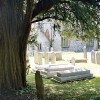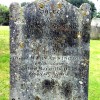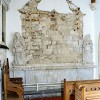In the spring of 1855 Simeon Vickery married Sarah Singleton, an event hurried along by the imminent arrival of their first child. By the end of the decade Simeon and Sarah had two sons and two daughters; in all during their time together they had nine children. Their last child, Samuel, was born at Wambrook on the 6th of February 1873. We know from the 1891 census that Simeon Vickery had passed away and all of the children had left home except for 16-year-old Samuel who was employed as an agricultural labourer. He and his mother lived at Bartlett Cottage in Wambrook.
Samuel moved to Dorchester, where in 1893 at the age of 20 he enlisted in the army and did his training at the Dorset Regiment’s Depot at the Dorchester Barracks. He served at home until 1897, when he went to India as part of the annual draft and joined the 1st Battalion of the Dorset Regiment who, at the time, formed part of the Tirah Field Forces. Within weeks Sam Vickery was facing hostile Afridi tribesmen at the North West Frontier.
On the 20th October 1897 he was part of a group attacking the Dargai Heights. Here he displayed great courage while rescuing a comrade; his actions won him the Victoria Cross. The citation reads: “…Private Vickery heroically ran down a rocky mountain slope and brought a wounded soldier back to cover under extremely heavy small arms fire… “ Later in the Waran Valley he became separated from his company and killed three tribesmen who attacked him.
He returned to England for treatment to a chipped bone in his foot and was in the military hospital at Netley near Southampton when Queen Victoria personally presented him with his Victoria Cross. His award was announced in the London Gazette on the 20th of May 1898. When he left hospital the towns of Chard, Dorchester and Cardiff gave him civic receptions. On arriving in Dorchester he was greeted by bands and cheering crowds.
But this was not the end of his military career. Vickery was now a Corporal and was soon off to South Africa with a mounted infantry section to face the Boers. He was captured by the enemy but after four days in captivity he managed to escape and rejoined his unit. He was wounded in the guerrilla war that followed the defeat of the Boers. He retired from the military and joined his mother, a married sister and one of his brothers who had moved from Dorset to Cardiff.
At the outbreak of the First World War he was back in service as a Regular Reservist and served as a Sergeant with the 1st Battalion at Ypres Salient. At the end of the war Sergeant Samuel Vickery V.C. returned to Cardiff, where he died in 1952.
The Dorset parish of Wambrook was transferred to Somerset in 1895.



